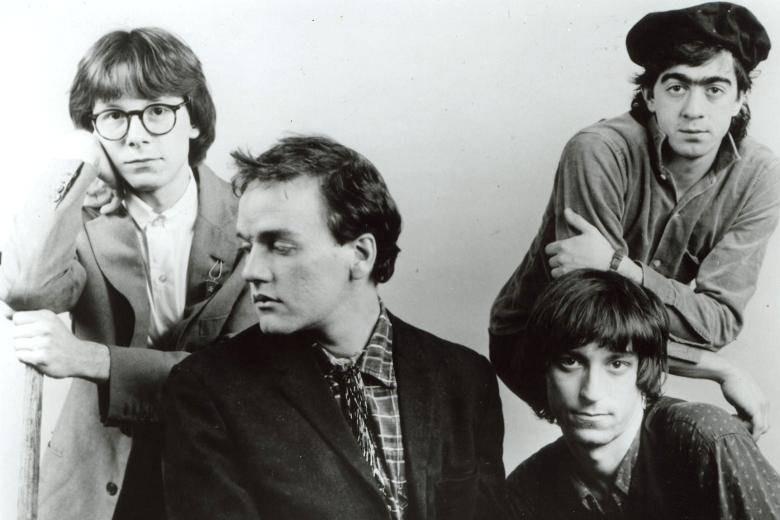
The story is a sad one, told many times, the story of their life and trying times. As much as the musical climate of the times, REM are a product of geography, rooted in the landscape and traditions of the American South. In the same way that The Clash will always be intrinsically linked to London, The Doors to Los Angeles, or Joy Division to Manchester, REM could only have crawled from the South.
Athens, Georgia is a college town. People come and go, some stay, some don’t. So it was back in 1980 when the four men that made up REM first came together. Michael Stipe, the very definition of ‘enigmatic frontman’ was a military brat, originally born in Georgia, but having grown up in a variety of locations. A photography and painting student, he found himself enrolled in the progressive art department of the University of Georgia, a painful shyness covering up a restless desire to create. Peter Buck was originally from California, and had found himself in and out of education, spending more time behind the desk in Athens’ Wuxtry records than he did in the classroom. Arguably, he got a better education in the record store.
Mike Mills is another Californian born kid, and it was in the town of Macon, Georgia, that he first met Minnesotan Bill Berry. The two overcame an initial awkwardness to become a tight rhythm section, eventually gravitating to the party scene of Athens, then undergoing an explosion of musical development. The B-52s had put the town on the map with their esoteric and exciting brand of new wave dance music, whilst artier bands like Pylon and The Method Actors were establishing a DIY scene that involved a community of people, predominantly artists rather than musicians, picking up whatever instrument they felt best suited them, and expressing themselves in whatever fashion they saw fit. Usually at a house party, with a plentiful supply of beer.
But despite the disparate origins of the four men, the mystery and magic of the south began to permeate the music they were making, weaving its way into the fabric of what would make them successful. The underdog spirit of the south, the isolation, and the sense of bruised history gifted to them from the American Civil war all formed vital components of the sound of REM, adding a weight to their initial clumsy rock and roll falterings.
Musically, the south had been primarily known for boogie rock bands like Lynryd Skynryd and the Allman Brothers, goodtime bands with a propensity for hard livin’ and hard rockin’. And whilst the Athens scene was fertile, the ‘longhairs’ still ruled the roost, always ready to show these arty students the real lay of the land. But the southern rock scene had crumbled in a mess of death, drugs, and financial irregularities. There was a vacuum, but punk wasn’t necessarily the force to fill it.
And permeating much of the culture of the south were the ghosts of the Civil War. To all extents and purposes, the South had lost, and these were wounds that were never truly healed. In the reconstruction of the United States in the aftermath of the Civil War, difficulties were papered over, a linger sense of resentment fermenting in the shadows. Indeed, the very landscape of Georgia was still littered with the emotional debris of the war, the confederate flag proudly flying from many a household, old plantations belonging to slave owners decaying back into the land. This wasn’t the modern and liberal north, cultural capitals like New York or San Francisco dominating the country whilst the South still smouldered. And it was in this climate that REM first came to prominence.
That isolationism gave the band a hard work ethic, practicing in the deconsecrated church on Oconee Street that most of the band called ‘home’ at one point or another. It gave them history as Stipe picked up on the speech patterns of Southern Preachers, absorbing the dialect and turns of phrase that had passed into history, but returned to life in his lips. And it gave them community, venues like The 40 Watt club and Tyrone’s providing a valuable space for the band to cut their teeth, to work out how to stand out, and to discover just what made them special.
And as the years went by, the records became full of references and touchstones to this forgotten land, REM being inextricable from the South. The cover of their debut, Murmur, features the kudzu vine, a plant that was spreading all over the state, covering everything in its leafy tendrils. The back cover proudly displays the trestle of the Georgia Railroad line, and iconic bit of Athens scenery. Reckoning features artwork from the noted primitive artist Howard Finster, whilst Fables of the Reconstruction is positively seeped in Southern Gothic imagery.
This would continue throughout their career, this sense of homespun honesty and location, popping up on album covers or in songs, references to Weaver D’s diner (“Automatic for the people”, Weaver would explain when serving up hot food), and even a tribute to a local BBQ house in ‘Walter’s Theme’, a b-side that ended up on Dead Letter Office. Even songs like ‘It’s the End of the World as we Know it (and I Feel Fine)’ would capture the alienation of these southern gentlemen as they went on an imagined trip to New York.
As the years went by, REM would embrace a more global consciousness, embracing environmentalism, Tibetan freedom, anti-Bush sentiment (first time round, no slouches, they), and helping to promote AIDS awareness. But all the way, they did it through a Georgian filter, promoting a ’think global, act local’ philosophy. They were socially active, yes, but U2 they were not.
And by maintaining their base of operations in Athens, they never quite deserted their hometown, despite eventually moving on to pastures new. But during the 80s, the band were regular sights on the streets of Athens, with the Butthole Surfers going on a bizarre pilgrimage to befriend REM, settling in the town for a year or so, before their own brand of psychic carnage drove them on.
Now that they’re gone, it’s almost as if REM have seeped into the very geography they once drew so much inspiration from. Bands have formed there because of them, and the four men have put money back into the city, helping to preserve the place that shaped them in their most formative stage. And of course, people still go on the pilgrimage to Athens to soak up where the band came from. The 40 Watt Club might have disappeared, Tyrone’s might have burnt to the ground, and the “Murmur Trestles” (as they became known) might have been declared structurally unsafe, but it’s all there, buried in the soil of the deep south.
“Automatic!” as Weaver D might say. Steven Rainey






